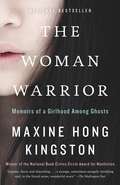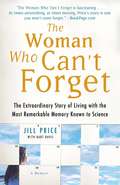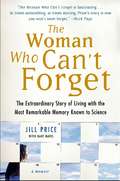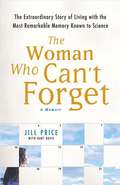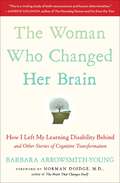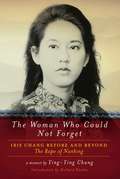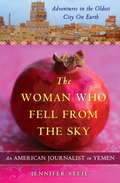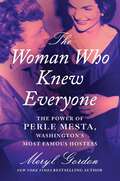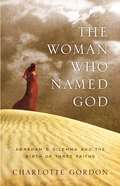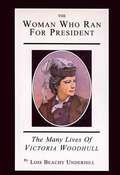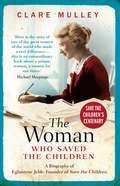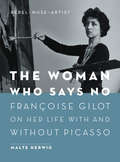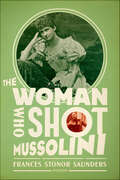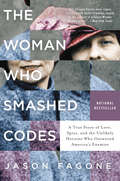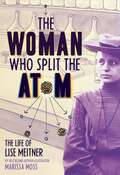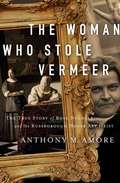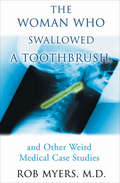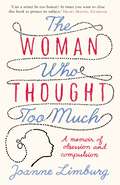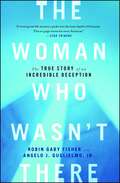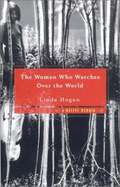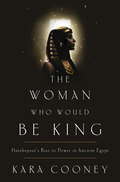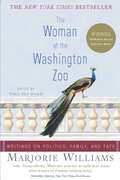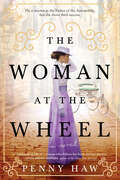- Table View
- List View
The Woman Warrior: Memoirs of a Girlhood Among Ghosts (Vintage International)
by Maxine Hong KingstonNATIONAL BESTSELLER • An exhilarating blend of autobiography and mythology, of world and self, of hot rage and cool analysis. First published in 1976, it has become a classic in its innovative portrayal of multiple and intersecting identities—immigrant, female, Chinese, American. <P><P> NATIONAL BOOK CRITICS CIRCLE AWARD WINNER <P><P> “A classic, for a reason.” —Celeste Ng, bestselling author of Little Fires Everywhere and Our Missing Hearts, via Twitter <P><P> As a girl, Kingston lives in two confounding worlds: the California to which her parents have immigrated and the China of her mother’s &“talk stories.” The fierce and wily women warriors of her mother’s tales clash jarringly with the harsh reality of female oppression out of which they come. Kingston’s sense of self emerges in the mystifying gaps in these stories, which she learns to fill with stories of her own. A warrior of words, she forges fractured myths and memories into an incandescent whole, achieving a new understanding of her family’s past and her own present.
The Woman Who Can't Forget
by Bart Davis Jill PriceJill Price has the first diagnosed case of a memory condition called "hyperthymestic syndrome" -- the continuous, automatic, autobiographical recall of every day of her life since she was fourteen. Give her any date from that year on, and she can almost instantly tell you what day of the week it was, what she did on that day, and any major world event or cultural happening that took place, as long as she heard about it that day. Her memories are like scenes from home movies, constantly playing in her head, backward and forward, through the years; not only does she make no effort to call her memories to mind, she cannot stop them. The Woman Who Can't Forget is the beautifully written and moving story of Jill's quest to come to terms with her extraordinary memory, living with a condition that no one understood, including her, until the scientific team who studied her finally charted the extraordinary terrain of her abilities. Her fascinating journey speaks volumes about the delicate dance of remembering and forgetting in all of our lives and the many mysteries about how our memories shape us. As we learn of Jill's struggles first to realize how unusual her memory is and then to contend, as she grows up, with the unique challenges of not being able to forget -- remembering both the good times and the bad, the joyous and the devastating, in such vivid and insistent detail -- the way her memory works is contrasted to a wealth of discoveries about the workings of normal human memory and normal human forgetting. Intriguing light is shed on the vital role of what's called "motivated forgetting"; as well as theories about childhood amnesia, the loss of memory for the first two to three years of our lives; the emotional content of memories; and the way in which autobiographical memories are normally crafted into an ever-evolving and empowering life story. Would we want to remember so much more of our lives if we could? Which memories do our minds privilege over others? Do we truly relive the times we remember most vividly, feeling the emotions that coursed through us then? Why do we forget so much, and in what ways do the workings of memory tailor the reality of what's actually happened to us in our lives? In The Woman Who Can't Forget, Jill Price welcomes us into her remarkable life and takes us on a mind-opening voyage into what life would be like if we didn't forget -- a voyage after which no reader will think of the magical role of memory in our lives in the same way again.
The Woman Who Can't Forget: The Extraordinary Story Of Living With The Most Remarkable Memory Known To Science
by Bart Davis Jill PricePeople might envy someone with such an extraordinary memory that she has been studied by neuroscientists, until they learn that Jill Price's ability extends only to details of her own life, sometimes haunting her, and does not to apply to memorizing facts. In collaboration with an established writer, this Los Angeles resident relates how she has coped since adolescence with hyperthymestic syndrome (defined in the glossary), in the context of current understanding of how memory works. This first-known case was documented in a 2006 journal article.
The Woman Who Changed Her Brain: And Other Inspiring Stories of Pioneering Brain Transformation
by Barbara Arrowsmith-YoungBarbara Arrowsmith-Young was born with severe learning disabilities that caused teachers to label her slow, stubborn—or worse. As a child, she read and wrote everything backward, struggled to process concepts in language, continually got lost, and was physically uncoordinated. She could make no sense of an analogue clock. But by relying on her formidable memory and iron will, she made her way to graduate school, where she chanced upon research that inspired her to invent cognitive exercises to “fix” her own brain. The Woman Who Changed Her Brain interweaves her personal tale with riveting case histories from her more than thirty years of working with both children and adults. Recent discoveries in neuroscience have conclusively demonstrated that, by engaging in certain mental tasks or activities, we actually change the structure of our brains—from the cells themselves to the connections between cells. The capability of nerve cells to change is known as neuroplasticity, and Arrowsmith-Young has been putting it into practice for decades. With great inventiveness, after combining two lines of research, Barbara developed unusual cognitive calisthenics that radically increased the functioning of her weakened brain areas to normal and, in some areas, even above-normal levels. She drew on her intellectual strengths to determine what types of drills were required to target the specific nature of her learning problems, and she managed to conquer her cognitive deficits. Starting in the late 1970s, she has continued to expand and refine these exercises, which have benefited thousands of individuals. Barbara founded Arrowsmith School in Toronto in 1980 and then the Arrowsmith Program to train teachers and to implement this highly effective methodology in schools all over North America. Her work is revealed as one of the first examples of neuroplasticity’s extensive and practical application. The idea that self-improvement can happen in the brain has now caught fire. The Woman Who Changed Her Brain powerfully and poignantly illustrates how the lives of children and adults struggling with learning disorders can be dramatically transformed. This remarkable book by a brilliant pathbreaker deepens our understanding of how the brain works and of the brain’s profound impact on how we participate in the world. Our brains shape us, but this book offers clear and hopeful evidence of the corollary: we can shape our brains.
The Woman Who Could Not Forget: Iris Chang Before and Beyond The Rape of Nanking
by Richard Rhodes Ying-Ying ChangThe poignant story of the life and death of world-famous author and historian Iris Chang, as told by her mother. Iris Chang's best-selling book The Rape of Nanking forever changed the way we view the Second World War in Asia. It all began with a photo of a river choked with the bodies of hundreds of Chinese civilians that shook Iris to her core. Who were these people? Why had this happened and how could their story have been lost to history? She could not shake that image from her head. She could not forget what she had seen. A few short years later, Chang revealed this "second Holocaust" to the world. The Japanese atrocities against the people of Nanking were so extreme that a Nazi party leader based in China actually petitioned Hitler to ask the Japanese government to stop the massacre. But who was this woman that single-handedly swept away years of silence, secrecy and shame? Her mother, Ying-Ying, provides an enlightened and nuanced look at her daughter, from Iris' home-made childhood newspaper, to her early years as a journalist and later, as a promising young historian, her struggles with her son's autism and her tragic suicide. The Woman Who Could Not Forget cements Iris' legacy as one of the most extraordinary minds of her generation and reveals the depth and beauty of the bond between a mother and daughter.
The Woman Who Fell from the Sky
by Jennifer Steil"I had no idea how to find my way around this medieval city. It was getting dark. I was tired. I didn't speak Arabic. I was a little frightened. But hadn't I battled scorpions in the wilds of Costa Rica and prevailed? Hadn't I survived fainting in a San José brothel? Hadn't I once arrived in Ireland with only $10 in my pocket and made it last two weeks? Surely I could handle a walk through an unfamiliar town. So I took a breath, tightened the black scarf around my hair, and headed out to take my first solitary steps through Sana'a."-- from The Woman Who Fell From The Sky In a world fraught with suspicion between the Middle East and the West, it's hard to believe that one of the most influential newspapers in Yemen--the desperately poor, ancestral homeland of Osama bin Laden, which has made has made international headlines for being a terrorist breeding ground--would be handed over to an agnostic, Campari-drinking, single woman from Manhattan who had never set foot in the Middle East. Yet this is exactly what happened to journalist, Jennifer Steil. Restless in her career and her life, Jennifer, a gregarious, liberal New Yorker, initially accepts a short-term opportunity in 2006 to teach a journalism class to the staff of The Yemen Observer in Sana'a, the beautiful, ancient, and very conservative capital of Yemen. Seduced by the eager reporters and the challenging prospect of teaching a free speech model of journalism there, she extends her stay to a year as the paper's editor-in-chief. But she is quickly confronted with the realities of Yemen--and their surprising advantages. In teaching the basics of fair and balanced journalism to a staff that included plagiarists and polemicists, she falls in love with her career again. In confronting the blatant mistreatment and strict governance of women by their male counterparts, she learns to appreciate the strength of Arab women in the workplace. And in forging surprisingly deep friendships with women and men whose traditions and beliefs are in total opposition to her own, she learns a cultural appreciation she never could have predicted. What's more, she just so happens to meet the love of her life. With exuberance and bravery, The Woman Who Fell from the Sky offers a rare, intimate, and often surprising look at the role of the media in Muslim culture and a fascinating cultural tour of Yemen, one of the most enigmatic countries in the world.From the Hardcover edition.
The Woman Who Knew Everyone: The Power of Perle Mesta, Washington's Most Famous Hostess
by Meryl GordonA TOWN & COUNTRY MUST READ BOOK OF 2025 AN AMAZON BEST BOOK OF THE MONTH - BIOGRAPHIES & MEMOIR A deeply researched biography of the socialite, political hostess, activist and United States envoy to Luxembourg, Perle Mesta, from New York Times bestselling author Meryl Gordon. Perle Mesta was a force to be reckoned with. In her heyday, this wealthy globe-trotting Washington widow was one of the most famous women in America, garnering as much media attention as Eleanor Roosevelt. Renowned for her world-class parties featuring politicians and celebrities, she was very close to three presidents–Harry Truman, Dwight Eisenhower and Lyndon Johnson. Truman named her as the first female envoy to Luxembourg, which inspired the hit musical based on Perle&’s life – &“Call Me Madam&” – which starred Ethel Merman, ran on Broadway for two years and later became a movie. A pioneering supporter of the Equal Rights Amendment, she was a prodigious Democratic fundraiser and rescued Harry Truman&’s financially flailing 1948 campaign. In this intensely researched biography, author Meryl Gordon chronicles Perle&’s lavish life and society adventures in Newport, Manhattan and Washington, while highlighting her important, but nearly forgotten contribution to American politics and the feminist movement.
The Woman Who Named God: Abraham's Dilemma and the Birth of Three Faiths
by Charlotte GordonThe saga of Abraham, Sarah, and Hagar is the tale of origin for all three monotheistic faiths. Abraham must choose between two wives who have borne him two sons. One wife and son will share in his wealth and status, while the other two are exiled into the desert. Long a cornerstone of Western anxiety, the story chronicles a very famous and troubled family, and sheds light on the ongoing conflict between the Judeo-Christian and Islamic worlds. How did this ancient story become one of the least understood and most frequently misinterpreted of our cultural myths? Gordon explores this legendary love triangle to give us a startling perspective on three biblical characters who--with their jealousies, passions, and doubts--actually behave like human beings. THE WOMAN WHO NAMED GOD is a compelling, smart, and provocative take on one of the Bible's most intriguing and troubling love stories.
The Woman Who Ran For President: The Many Lives of Victoria Woodhull
by Lois Beachy UnderhillVictoria Woodhull was a feminist pioneer who rose up from poverty to become the first woman Wall Street broker, the first woman to testify before Congress and the first woman to run for president. A beautiful woman and a spellbinding public speaker, she was also a figure of scandal--a divorcee and practicing clairvoyant turned muckracking newspaper publisher, a free-love advocate (and practitioner), and a socialist.
The Woman Who Saved the Children: A Biography of Eglantyne Jebb: Founder of Save the Children
by Clare MulleySince 1919 Save the Children has fought to uphold the human rights of children worldwide. Now promoted by the likes of Brad Pitt, George Clooney, and Julianne Moore the charity's founder was a childless spinster whose most famous line, 'I don't care for children' makes hers a most unconventional story. Eglantyne's short life was full of passion and pain, moving from illicit romance in Cambridge to espionage in Serbia. Her achievements in putting children's universal human rights on the world agenda are a powerful testament to her eccentric charisma and humane vision. Clare Mulley joined Save the Children as a corporate fundraiser in the 1990s. Mother of three daughters, she currently lives in Essex, UK.
The Woman Who Says No: Françoise Gilot on Her Life With and Without Picasso - Rebel, Muse, Artist
by Malte HerwigPablo Picasso called Françoise Gilot "The Woman Who Says No." Tiny, talented, and feisty, and an accomplished artist in her own right, Gilot left Picasso after a ten-year relationship, the only woman to escape his intense attentions unscathed. From 2012 to 2014, German journalist and author Malte Herwig dropped by her ateliers in Paris and New York to chat with her about life, love, and art. She shared trenchant observations, her sharp sense of humor, and over ninety years of experience, much of it in the company of men who changed the world: Picasso, Matisse, and her second husband, the famous virologist Jonas Salk, developer of the polio vaccine. Never one to stand in the shadows, Gilot engaged with ground-breaking artists and scientists on her own terms, creating from these vital interactions an artistic style all her own, translated into an enormous collection of paintings and drawings held by private collectors and public museums around the world. In her early nineties, she generously shared her hospitality and wisdom with Herwig, who started out as an interviewer but found himself drawn into the role of pupil as Gilot, whom he called "a philosopher of joy," shared with him different ways of seeing the world.
The Woman Who Shot Mussolini: A Biography
by Frances Stonor SaundersThe astonishing untold story of a woman who tried to stop the rise of Fascism and change the course of historyAt 11 a.m. on Wednesday, April 7, 1926, a woman stepped out of the crowd on Rome's Campidoglio Square. Less than a foot in front of her stood Benito Mussolini. As he raised his arm to give the Fascist salute, the woman raised hers and shot him at point-blank range. Mussolini escaped virtually unscathed, cheered on by practically the whole world. Violet Gibson, who expected to be thanked for her action, was arrested, labeled a "crazy Irish spinster" and a "half-mad mystic"—and promptly forgotten. Now, in an elegant work of reconstruction, Frances Stonor Saunders retrieves this remarkable figure from the lost historical record. She examines Gibson's aristocratic childhood in the Dublin elite, with its debutante balls and presentations at court; her engagement with the critical ideas of the era—pacifism, mysticism, and socialism; her completely overlooked role in the unfolding drama of Fascism and the cult of Mussolini; and her response to a new and dangerous age when anything seemed possible but everything was at stake.In a grand tragic narrative, full of suspense and mystery, conspiracy and backroom diplomacy, Stonor Saunders vividly resurrects the life and times of a woman who sought to forestall catastrophe, whatever the cost.
The Woman Who Smashed Codes: A True Story of Love, Spies, and the Unlikely Heroine Who Outwitted America's Enemies
by Jason FagoneJoining the ranks of Hidden Figures and In the Garden of Beasts, the incredible true story of the greatest codebreaking duo that ever lived, an American woman and her husband who invented the modern science of cryptology together and used it to confront the evils of their time, solving puzzles that unmasked Nazi spies and helped win World War II.In 1916, at the height of World War I, brilliant Shakespeare expert Elizebeth Smith went to work for an eccentric tycoon on his estate outside Chicago. The tycoon had close ties to the U.S. government, and he soon asked Elizebeth to apply her language skills to an exciting new venture: code-breaking. There she met the man who would become her husband, groundbreaking cryptologist William Friedman. Though she and Friedman are in many ways the "Adam and Eve" of the NSA, Elizebeth’s story, incredibly, has never been told.In The Woman Who Smashed Codes, Jason Fagone chronicles the life of this extraordinary woman, who played an integral role in our nation’s history for forty years. After World War I, Smith used her talents to catch gangsters and smugglers during Prohibition, then accepted a covert mission to discover and expose Nazi spy rings that were spreading like wildfire across South America, advancing ever closer to the United States. As World War II raged, Elizebeth fought a highly classified battle of wits against Hitler’s Reich, cracking multiple versions of the Enigma machine used by German spies. Meanwhile, inside an Army vault in Washington, William worked furiously to break Purple, the Japanese version of Enigma—and eventually succeeded, at a terrible cost to his personal life.Fagone unveils America’s code-breaking history through the prism of Smith’s life, bringing into focus the unforgettable events and colorful personalities that would help shape modern intelligence. Blending the lively pace and compelling detail that are the hallmarks of Erik Larson’s bestsellers with the atmosphere and intensity of The Imitation Game, The Woman Who Smashed Codes is page-turning popular history at its finest.
The Woman Who Split the Atom: The Life of Lise Meitner
by Marissa MossAs a female Jewish physicist in Berlin during the early 20th century, Lise Meitner had to fight for an education, a job, and equal treatment in her field, like having her name listed on her own research papers. <P><P>Meitner made groundbreaking strides in the study of radiation, but when Hitler came to power in Germany, she suddenly had to face not only sexism, but also life-threatening anti-Semitism as well. Nevertheless, she persevered and one day made a discovery that rocked the world: the splitting of the atom. While her male lab partner was awarded a Nobel Prize for the achievement, the committee refused to give her any credit. <P><P>Suddenly, the race to build the atomic bomb was on—although Meitner was horrified to be associated with such a weapon. “A physicist who never lost her humanity,” Meitner wanted only to figure out how the world works, and advocated for pacifism while others called for war. <P><P>The book includes an afterword, author's note, timeline, select terms of physics, glossary of scientists mentioned, endnotes, select bibliography, index, and Marissa Moss’s celebrated drawings throughout. The Woman Who Split the Atom is a fascinating look at Meitner’s fierce passion, integrity, and her lifelong struggle to have her contributions to physics recognized.
The Woman Who Stole Vermeer: The True Story of Rose Dugdale and the Russborough House Art Heist
by Anthony M. AmoreThe extraordinary life and crimes of heiress-turned-revolutionary Rose Dugdale, who in 1974 became the only woman to pull off a major art heist.In the world of crime, there exists an unusual commonality between those who steal art and those who repeatedly kill: they are almost exclusively male. But, as with all things, there is always an outlier—someone who bucks the trend, defying the reliable profiles and leaving investigators and researchers scratching their heads. In the history of major art heists, that outlier is Rose Dugdale. Dugdale&’s life is singularly notorious. Born into extreme wealth, she abandoned her life as an Oxford-trained PhD and heiress to join the cause of Irish Republicanism. While on the surface she appears to be the British version of Patricia Hearst, she is anything but. Dugdale ran head-first towards the action, spearheading the first aerial terrorist attack in British history and pulling off the biggest art theft of her time. In 1974, she led a gang into the opulent Russborough House in Ireland and made off with millions in prized paintings, including works by Goya, Gainsborough, and Rubens, as well as Lady Writing a Letter with her Maid by the mysterious master Johannes Vermeer. Dugdale thus became—to this day—the only woman to pull off a major art heist. And as Anthony Amore explores in The Woman Who Stole Vermeer, it&’s likely that this was not her only such heist. The Woman Who Stole Vermeer is Rose Dugdale&’s story, from her idyllic upbringing in Devonshire and her presentation to Elizabeth II as a debutante to her university years and her eventual radical lifestyle. Her life of crime and activism is at turns unbelievable and awe-inspiring, and sure to engross readers.
The Woman Who Swallowed a Toothbrush: And Other Bizarre Medical Cases
by Rob MyersDrawing from real medical journal cases, a doctor shares true stories about strange symptoms and perplexing patients. Those in the medical profession know that sometimes the cases that come into emergency rooms or doctor&’s offices can be highly unusual—and depending on how things go, the results can be either tragic or comic. This collection of stories reveals some of the oddest and most memorable case histories, from the woman who claims she was brushing her teeth when she swallowed her toothbrush—but in fact was a bulimic using it to induce vomiting—to the man whose routine elective back surgery revealed he&’d been carrying a bullet around in his body for years. From the funny to the frightening, these documented memorable medical mysteries make for fascinating reading.
The Woman Who Thought too Much: A Memoir
by Joanne LimburgFor readers of A Year of Magical Thinking by Joan Didion and Bad Blood by Lorna Sage comes an intensely honest and surprisingly witty literary memoir of one woman's life as a sufferer of Obsessive-compulsive disorder Joanne Limburg is a woman who thinks things she doesn't want to think, and who does things she doesn't want to do. As a small child, she would chew her hair all day and lie awake at night wondering if heaven had a ceiling; a few years later, when she should have been doing her homework, she was pacing her bedroom, agonizing about the unfairness of life as a woman, and the shortness of her legs. By the time she was an adult, obsessive thoughts and compulsive behaviors had come to dominate her life. She knew that something was wrong with her, but it would take many years before she understood what that something was. This memoir follows Limburg's quest to understand her OCD and to manage her symptoms, taking the reader on a journey through consulting rooms, libraries, and websites as she learns about rumination, scrupulosity, avoidance, thought-action fusion, fixed-action patterns, anal fixations, schemas, basal ganglia, tics, and synapses. Meanwhile, she does her best to come to terms with an illness that turns out to be common and even—sometimes—treatable. This vividly honest memoir is a sometimes shocking, often humorous revelation of what it is like to live with so debilitating a condition. It is also an exploration of the inner world of a poet and an intense evocation of the persistence and courage of the human spirit in the face of mental illness.
The Woman Who Wasn't There: The True Story of an Incredible Deception
by Robin Gaby Fisher Angelo J Guglielmo Jr.It was a tale of loss and recovery, of courage and sorrow, of horror and inspiration. Tania Head’s astonishing account of her experience on September 11, 2001—from crawling through the carnage and chaos to escaping the seventy-eighth-floor sky lobby of the burning south tower to losing her fiancé in the collapsed north tower—transformed her into one of the great victims and heroes of that tragic day. Tania selflessly took on the responsibility of giving a voice and a direction to the burgeoning World Trade Center Survivors’ Network, helping save the “Survivor Stairway” and leading tours at Ground Zero, including taking then-governor Pataki, Mayor Bloomberg, and former mayor Giuliani on the inaugural tour of the WTC site. She even used her own assets to fund charitable events to help survivors heal. But there was something very wrong with Tania’s story—a terrible secret that would break the hearts and challenge the faith of all those she claimed to champion. Told with the unique insider perspective and authority of Angelo J. Guglielmo, Jr., a filmmaker shooting a documentary on the efforts of the Survivors’ Network, and previously one of Tania’s closest friends, The Woman Who Wasn’t There is the story of one of the most audacious and bewildering quests for acclaim in recent memory—one that poses fascinating questions about the essence of morality and the human need for connection at any cost.
The Woman Who Watches Over the World: A Native Memoir
by Linda HoganHogan, a poet, novelist, essayist, and author of ten previous books, recounts the development of her American-Indian identity, her difficult childhood as the daughter of an army sergeant, her love affair at the age of 12 with an older man, and the troubled history of the two daughters she adopted. Revealing how historic and emotional pain are passed down through generations, she blends personal history with stories of important Indian figures of the past such as Lozen, the woman who was the military strategist for Geronimo, and Ohiyesha, the medical doctor who witnessed the massacre at Wounded Knee.
The Woman Who Would Be King: Hatshepsut's Rise to Power in Ancient Egypt
by Kara CooneyAn engrossing biography of the longest-reigning female pharaoh in Ancient Egypt and the story of her audacious rise to power. Hatshepsut--the daughter of a general who usurped Egypt's throne and a mother with ties to the previous dynasty--was born into a privileged position in the royal household, and she was expected to bear the sons who would legitimize the reign of her father's family. Her failure to produce a male heir was ultimately the twist of fate that paved the way for her improbable rule as a cross-dressing king. At just over twenty, Hatshepsut ascended to the rank of pharaoh in an elaborate coronation ceremony that set the tone for her spectacular reign as co-regent with Thutmose III, the infant king whose mother Hatshepsut out-maneuvered for a seat on the throne. Hatshepsut was a master strategist, cloaking her political power plays in the veil of piety and sexual reinvention. Just as women today face obstacles from a society that equates authority with masculinity, Hatshepsut shrewdly operated the levers of power to emerge as Egypt's second female pharaoh.Hatshepsut successfully negotiated a path from the royal nursery to the very pinnacle of authority, and her reign saw one of Ancient Egypt's most prolific building periods. Scholars have long speculated as to why her monuments were destroyed within a few decades of her death, all but erasing evidence of her unprecedented rule. Constructing a rich narrative history using the artifacts that remain, noted Egyptologist Kara Cooney offers a remarkable interpretation of how Hatshepsut rapidly but methodically consolidated power--and why she fell from public favor just as quickly. The Woman Who Would Be King traces the unconventional life of an almost-forgotten pharaoh and explores our complicated reactions to women in power.From the Hardcover edition.
The Woman and the Myth: Margaret Fuller's Life and Writings
by Bell G. ChevignyThough generally overshadowed by Ralph Waldo Emerson and other New England intellectuals, Margaret Fuller spoke out boldly for social reform and the rights of women. She edited The Dial magazine, and she was a regular contributor to Horace Greeley's New York Tribune. In her thirties she left New England to travel in Europe, and her life was transformed by the political upheaval in Italy. She became a close friend of the revolutionary Giuseppe Mazzini, fell in love with an Italian count, bore a child, cared for the war wounded, and perished in a shipwreck at the age of forty. This book is a collection of excerpts from Fuller's letters and essays, observations about Fuller by her contemporaries, and the author's biographical chapters.
The Woman at the Washington Zoo: Writings on Politics, Family, and Fate
by Marjorie WilliamsOne of Washington's finest writers on people, politics, and life ? collected for the first time.
The Woman at the Well
by Melinda BuschIn Jesus' day, it was not proper for a Jew to eat with a Samaritan. But Jesus asked her for a drink anyway. Then, He told her about God's living water.
The Woman at the Wheel: A Novel
by Penny HawInspiring historical fiction based on the real life of Bertha Benz, whose husband built the first prototype automobile, which eventually evolved into the Mercedes-Benz marque."Unfortunately, only a girl again."From a young age, Cäcilie Bertha Ringer is fascinated by her father's work as a master builder in Pforzheim, Germany. But those five words, which he wrote next to her name in the family Bible, haunt Bertha.Years later, Bertha meets Carl Benz and falls in love—with him and his extraordinary dream of building a horseless carriage. Bertha has such faith in him that she invests her dowry in his plans, a dicey move since they alone believe in the machine. When Carl's partners threaten to withdraw their support, he's ready to cut ties. Bertha knows the decision would ruin everything. Ignoring the cynics, she takes matters into her own hands, secretly planning a scheme that will either hasten the family's passage to absolute derision or prove their genius. What Bertha doesn't know is that Carl is on the cusp of making a deal with their nemesis. She's not only risking her marriage and their life's work, but is also up against the patriarchy, Carl's own self-doubt, and the clock.Like so many other women, Bertha lived largely in her husband's shadow, but her contributions are now celebrated in this inspiring story of perseverance, resilience, and love.
